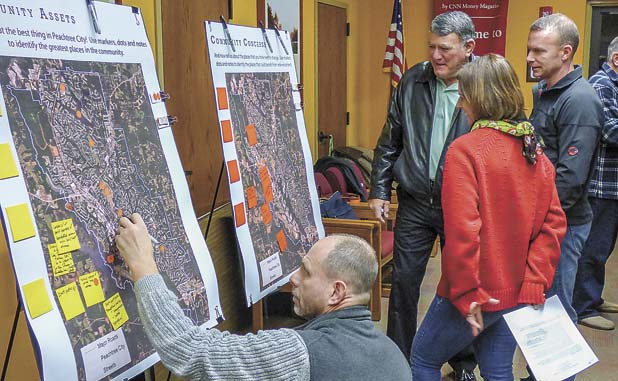Those attending the Peachtree City Comprehensive Plan open house on Dec. 8 had their say on what the city should look like in the coming years. Among those attending, standing at left, was Councilman Mike King. Photo/Ben Nelms.
Peachtree City is in the beginning phase of deciding on its Comprehensive Plan that will set the tone for what the city looks like in the coming years. The open house to get things rolling was held Dec. 8.
Residents attending the open house in the city’s planning department surveyed a number of posters and provided comments.
As important as anything was the city’s vision, “To promote our status as a pre-eminent planned community by enhancing and strengthening our comprehensive plan to enrich and improve the quality of life for our residents; the educational, recreational and cultural resources for citizens of all ages; and, the technical and physical resources for our businesses and industries, while embracing the preserving greenspace, aesthetics and the overall character of the community.”
Near the end of the meeting, the voting showed 14 people supporting the vision and none opposed. Suggestions included providing infrastructure for technology to support tele-commuting.
Those attending the meeting, geared as interactive with city staff, elected officials and staff from the Atlanta Regional Commission (ARC) on-hand, provided input on the major goal categories that included transportation, housing, land use, community aesthetics, commercial and economic development.
On the transportation goal, nearly all survey respondents said the 14 areas outlining the goal remained relevant.
Respondents to the Housing goal also largely agreed with the 10 stated areas. One area that received five votes indicating continued relevance and five others indicating less relevance dealt with the providing “a variety of housing prices by encouraging innovative residential developments and housing types in accordance with the existing Land Use Plan.”
On the land use goal of establishing appropriate uses, nearly all agreed, and with the majority believing the city should follow the village concept and that the city should work with the county in encouraging developments on the perimeter of the city that resemble the city’s interior.
The community aesthetics survey had a large number of respondents wanting to maintain the need to preserve and enhance the city’s visual image and appearance.
The commercial survey board had few comments that deviated from the goal of concentrating commercial spaces in the five village centers.
As with the other goal categories, the economic development survey and its nine sub-sections received nearly unanimous support. The goal calls for maintaining a diversified economy that encourages high-paying jobs and maximum tax contribution.
One sub-section that received to votes for less relevance, compared to one vote for “still relevant,” dealt with working closely with the county and local organizations so the entire county can be marketed in such a way that benefits the entire county.
On the community concerns board, attendees were asked to provide input on the areas of the city that need to be redeveloped. Among the comments were those indicating that commercial development should be hidden by landscaping and that cart paths should connect all homes to businesses.
Residents also added comments to the community assets board, having their say on what they saw as the greatest places in the city.
One of the data areas provided by ARC related to employment and the number of city residents who work outside the city and the number who travel to Peachtree City for work. Those numbers mirror Fayette County, a largely bedroom community in which a significant majority of of working-age people leave the county each day for work.
Data showed 12,257 Peachtree City residents leaving the city for work each day while 13,092 people travel to the city to work. Only 2,459 people both live and work in the city.
The open house was first of several public meeting that will occur in 20017 as the planning and community input phases of the comprehensive plan development are completed.






